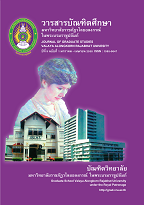ผลสัมฤทธิ์การบริหารจัดการสหกรณ์เครดิตยูเนี่ยนเพื่อความยั่งยืนของเศรษฐกิจชุมชน ภาคตะวันออกเฉียงเหนือตอนบน
Main Article Content
Abstract
การวิจัยครั้งนี้มีวัตถุประสงค์เพื่อการวิจัย เพื่อศึกษา 1) นโยบายสหกรณ์ของรัฐบาลกับนโยบายสหกรณ์เครดิตยูเนี่ยน 2) ศักยภาพการบริหารสหกรณ์เครดิตยูเนี่ยน เพื่อสร้างความยั่งยืนเศรษฐกิจชุมชน 3) ผลสัมฤทธิ์การบริหารสหกรณ์เครดิตยูเนี่ยน โดยใช้รูปแบบการผสานวิธี ได้แก่ การวิจัยเชิงปริมาณและการวิจัยเชิงคุณภาพ การวิจัยเชิงปริมาณ ประชากร ได้แก่ ประชาชนที่ขี้นทะเบียนเป็นสมาชิกสหกรณ์เครดิตยูเนี่ยนทั้ง 5 แห่ง คือ สหกรณ์เครดิตยูเนี่ยนพระบาทนาสิงห์ สหกรณ์เครดิตยูเนี่ยนโพธิ์หมากแข้ง สหกรณ์เครดิตยูเนี่ยนห้วยหลัวสามัคคี สหกรณ์เครดิตยูเนี่ยนบ้านดุงสามัคคี สหกรณ์เครดิตยูเนี่ยนท่าแร่ จำนวน 17,335 คน ได้กลุ่มตัวอย่าง จำนวน 376 คน ซึ่งคำนวณได้จากการเปิดตารางของเครซี่มอแกน ที่ระดับนัยสำคัญทางสถิติ .05 วิธีการสุ่มตัวอย่างแบบหลายขั้นตอน (Multi Stage Sampling) แบ่งเป็นการสุ่มตัวอย่างแบบแบ่งชั้นภูมิ (Stratified Sampling) และการสุ่มตัวอย่างแบบง่าย (Sample Random Sampling) เครื่องมือที่ใช้ในการวิจัยเป็นแบบสอบถาม มีระดับความเชื่อมั่นเท่ากับ 0.98 สถิติที่ใช้ในการวิจัย ได้แก่ ค่าความถี่ ค่าร้อยละ สำหรับการวิจัยเชิงคุณภาพ ประชากร ได้แก่ ผู้มีบทบาทสำคัญในการกำหนดนโยบาย และการบริหารจัดการสหกรณ์เครดิตยูเนี่ยน จำนวน 15 คนดำเนินการสัมภาษณ์เชิงลึก และผู้ปฏิบัติตามนโยบายสหกรณ์เครดิตยูเนี่ยน จำนวน 90 คน ดำเนินการสนทนากลุ่ม ได้มาโดยการเลือกแบบเจาะจง เก็บข้อมูลโดยการสัมภาษณ์เชิงลึก วิเคราะห์ข้อมูลด้วยการแปลความ การตีความ และวิเคราะห์ความ
ผลการวิจัยพบว่า
1. นโยบายสหกรณ์เครดิตยูเนี่ยนมีวัตถุประสงค์การพัฒนาศักยภาพของชุมชนอย่างชัดเจนและมีขั้นตอนการพัฒนาที่เป็นระบบ โดยเริ่มตั้งแต่ระดับบุคคล ระดับครอบครัว และระดับชุมชนพร้อมทั้งมีความเชื่อมโยงและสอดคล้องกันกับนโยบายด้านการพัฒนาเศรษฐกิจและสังคมของรัฐบาลทุกประการ
2. ศักยภาพการบริหารจัดการสหกรณ์เครดิตยูเนี่ยนโดยภาพรวมมีจุดเด่น ได้แก่ การบริหาร งานบุคคลที่เป็นระบบ มวลสมาชิกสามารถบริหารจัดการด้วยตนเอง จุดด้อย ได้แก่ มวลสมาชิกยังขาดความรู้ความเข้าใจในหลักการสหกรณ์เครดิยูเนี่ยนอย่างถ่องแท้และมีความเข้าใจอย่างคลาดเคลื่อนกับอุดมการณ์สหกรณ์เครดิตยูเนี่ยน โอกาส ได้แก่ หน่วยงานทางการศึกษา หน่วยงานราชการ และสถาบันการเงิน เริ่มให้ความสนใจต่อแนวทางการบริหารจัดการสหกรณ์เครดิตยูเนี่ยนเพิ่มมากขึ้น วิกฤติ ได้แก่ มวลสมาชิกสหกรณ์เครดิตยูเนี่ยนยังไม่ตระหนักถึงอุดมการณ์สหกรณ์เครดิตยูเนี่ยนอย่างแท้จริงกระบวนการปลูกฝังของสหกรณ์ยังทำไม่ได้อย่างเต็มที่เป็นแต่เพียงการดำเนินการตามขั้นตอนเท่านั้น
3. ผลสัมฤทธิ์การบริหารจัดการสหกรณ์เครดิตยูเนี่ยนเพื่อความยั่งยืนของเศรษฐกิจชุมชนในภาคตะวันออกเฉียงเหนือ สรุปได้ดังนี้ วัตถุประสงค์ชัดเจน มีเงินทุนหมุนเวียน สมาชิกพึ่งตนเองได้และสามารถชำระหนี้ได้ ภาระหนี้สินลดลง สมาชิกมีความสามัคคีกันมากขึ้น ระดับคุณธรรมจริยธรรมสูงขึ้น ภาครัฐให้การสนับสนุน มีทรัพยากรการบริหารเพียงพอ มีทัศนคติที่ดีในการทำงาน และการมีส่วนร่วมของสมาชิก
The objective of this research were 1) to study the government policy on the cooperative Credit Union, 2) to study the potential of the policy of cooperative Credit Union management for sustainability of the community economy and 3) to study the achievement of cooperative credit union management. The research employed the mixed method combining both the quantitative and quantitative techniques. The quantitative research comprised the 5 cooperative Credit Unions including PhrabhatNasing, Phomakkhang, Huayn Samakkee, Bandung Samakee and Tharae pattana. The population were 17,335 registered members and the samples were 376 respondent selected from the Krejcie and Morgan table. The multistage sampling method was used. The tool for data collection was questionnaire at a confidence level of 0.98. Statistics used to analyze data were frequency, percentage and mean and standard deviation. The equalization research was conducted by using the in-depth interviews with the 15 key informants selected from the policy makers and 90 participants with focus group discussion and selected by a purposive sampling technique. The data were analyzed by content analysis and interpretation.
The research findings were as follows:
1. The government Policy on Credit Union had clearly developed potential of community and proceeded systematically. The processes of the cooperative Credit Union started from individual level, family level and community level respectively in accordance with the socio-economic development policy of the government.
2. The potential of cooperative Credit Union management for sustainability of the community economy consisted of the systematic management of personnel, the member’s ability to self-management and the cooperation among institutions such as educational institution, the government institution and financial institution in management of the cooperative Credit Union.
3. The achievement of Cooperative Credit Union management had been found that in overall the operation could obtain the objectives of the cooperative Credit Union; the unobstructed flow of the capital, the member’s ability to self- reliance and their mutual assistance, the debt reduction and more cooperation, high level of morality and integrity, the government’s increasing support and the members’ gaining more knowledge and understanding of the Credit Union and finally the increasing managerial skills of the management staff.
Article Details

This work is licensed under a Creative Commons Attribution-NonCommercial-NoDerivatives 4.0 International License.
บทความทุกเรื่องได้รับการตรวจความถูกต้องทางวิชาการโดยผู้ทรงคุณวุฒิ ทรรศนะและข้อคิดเห็นในบทความ Journal of Global of Perspectives in Humanities and Social Sciences (J-GPHSS) มิใช่เป็นทรรศนะและความคิดของผู้จัดทำจึงมิใช่ความรับผิดชอบของบัณฑิตวิทยาลัย มหาวิทยาลัยราชภัฏวไลยอลงกรณ์ ในพระบรมราชูปถัมภ์ กองบรรณาธิการไม่สงวนสิทธิ์การคัดลอก แต่ให้อ้างอิงแหล่งที่มา


